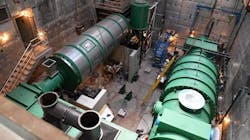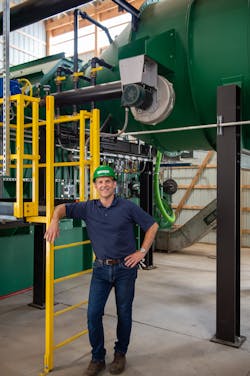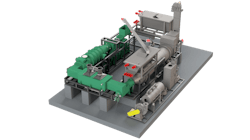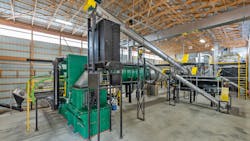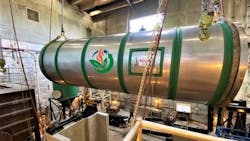Innovation in Thermal Treatment
The City of Edmonds near Seattle is constantly looking for ways to improve sustainability at its activated sludge plant, which serves a population of 75,000 (11.8 million gallons per day design, 4 mgd average in summer, 6.5 mgd in winter). The facility is located on the edge of Puget Sound adjacent to the ferry terminal to the San Juan Islands with dramatic views of the Olympic mountains in the distance.
For more than a decade, the City has worked closely with long-time partner Ameresco, an energy services company, and the Washington Department of Enterprise Services to implement an ambitious Pathway to Sustainability program at the plant that will ultimately reduce fossil fuel consumption by 45%. The Water Environment Federation recognized Edmonds as a Utility of the Future Today in 2020 for its energy efficiency upgrades.
In 2017, Edmonds’ city council further increased its commitment to sustainability by working to achieve or exceed the goals of the Paris Climate Accord for local clean energy supply.
The utility is now well into the next step on the Path to Sustainability: replacing the 30-year-old fluidized bed sewage sludge incinerator with an integrated drying and gasification process.
Ambitious Sustainability Goals with Major Site Constraints
For several years, the utility explored sustainable solids processing technologies that could realistically replace the aging incinerator and fit in the same building. Following two screw presses, the incinerator operated in a below-grade room that was 56 x 39 feet, and 37 feet tall. The only access to move equipment in and out of the building would be a 12 x 12 feet hatch in the wall.
“Because of our site constraints in a residential neighborhood, we didn’t have a lot of options,” says Pamela Randolph, plant superintendent. “There was no way to expand outside the existing footprint of the plant. The incinerator was definitely on its last leg, and we struggled to find a viable technology.”
Due to the residential location, it was important to minimize truck traffic and any odors associated with hauling to an off-site processing facility or land application sites. Landfill tip fees were too high to be seriously considered and did not meet sustainability goals.
Anaerobic digestion required too much space, and the digestate would still require considerable truck traffic to haul off-site.
A new incinerator was ruled out due to high capital and operating expenses, as well as the challenges of meeting the strict emissions requirements of the United States Environmental Protection Agency’s 2016 Sewage Sludge Incineration (SSI) Rule.
Fluidized (“bubbling”) bed gasification was too costly and lacked operational data. Downdraft gasification required hauling in wood chips for co-gasification, increasing truck traffic instead of reducing it.
Biodryers followed by pyrolysis would have achieved the utility’s energy efficiency goals, but there was no space for a biodryer, let alone multiple units that would be needed. Combining belt dryers with pyrolysis required a smaller footprint, but the thermal energy recovered from pyrolysis would only offset about half of the natural gas demand for the belt dryers. With or without pyrolysis, belt dryers would have required a new building taking up half of the parking lot, but a building tall enough to house them would have required obtaining a variance to local height restriction code.
“Then, in 2019, we learned about a full-scale demonstration of a process called Fluid Lift Gasification near Philadelphia,” says Randolph. “Especially after we toured the facility and fabrication shop, it was clear that the process was the best fit for our unique situation.”
Compact, Energy-Positive Thermal Treatment
Edmonds’ technology partner is Ecoremedy LLC, a Pennsylvania company that provides turnkey drying and gasification systems to municipal wastewater utilities.
“The demonstration in Morrisville was our largest biosolids project to date,” says David Mooney, Ecoremedy President and Chief Technology Officer. “Despite the challenge of daily start-up and shutdown due to permitting delays from COVID-19, the project consistently achieved an average hourly throughput of 1.5 wet tons per hour to the system, with a peak of 2 wet tons per hour.”
To replace the incinerator and account for future population growth, the design capacity needed in Edmonds was 1.25 wet tons per hour of sludge to the system (14,250 wet tons per year), which the Morrisville Project had achieved.
Engineering, permitting and construction of the Morrisville Biosolids Gasification Pilot Project began in 2018 in southeast Pennsylvania. Commissioning began within 12 months of a signed contract with the Morrisville Municipal Authority for biosolids supply and temporary use of a greenfield site adjacent to the press building. Ecoremedy operated the full-scale demonstration for two years under a build-own-operate-maintain (BOOM) structure on a tip-fee basis. The system is being relocated to a permanent site at a municipal wastewater treatment facility in Pennsylvania in 2022.
“Ecoremedy’s advanced gasification technology has processed animal waste for decades without any issues,” says Mooney. “In Morrisville, we were pleased with the performance of the gasifier when operating exclusively on pressed wastewater treatment sludge. Our engineering team ultimately made minimal changes for the Edmonds design. Operational data and results from an odor study conducted during the pilot were critical for air permitting in Edmonds, as well as obtaining a non-incineration designation from the EPA. Of course, like any good pilot, we learned a lot about how not to do things and those insights were invaluable for the Edmonds Project.”
As Mooney describes it, Ecoremedy combines a proven state-of-the-art gasifier with a conventional rotary drum drying facility. “The gasifier was designed to process high-ash, high-moisture feedstocks, and it has more than 10,000 operational hours running continuously on manure and biosolids feedstocks since 2001. Our engineering team includes global experts in biosolids drying and gasification which allows us to properly integrate the two technologies.” He added, “The gasifier can be taken completely offline, and the dryer can run solely on natural gas if needed.”
Instead of a traditional furnace to supply heat to the dryer, Ecoremedy’s proprietary quiescent bed updraft gasification system (60 to 90 minutes at 1,400 to 1,700 degrees Fahrenheit) will convert the sludge from Edmonds’ screw press (26.5% total solids) to syngas, similar to a digester converting biosolids to biogas. The syngas is then combusted in a thermal oxidizer, which destroys vapor-phase PFAS and creates 2,000 F exhaust gas. The hot exhaust gas provides more thermal energy than needed for drying, even with digested sludge. Excess thermal energy is used for plume abatement.
The Ecoremedy process can maximize generation of dried Class A biosolids or custom FlexChar®, a variable carbon content biochar, or reduce all the biosolids to the ash-fraction to maximize energy recovery and reduce outgoing volume by up to 98%.
Industrial Origami
Ecoremedy’s Fluid Lift Gasification was ultimately approved unanimously by the Edmonds city council as the technology to replace the incinerator.
The Director of Public Works at the time was especially appreciative that Ecoremedy’s scope included supplying all equipment from the sludge receiving bin through the process discharge vent, including the gasification process, drying, material handling, and pollution control.
“In order to shoehorn the system into a two-story building, the design team creatively applied ‘industrial origami’ to fold the system in half horizontally and again vertically,” says Mooney.
In addition to pressed sludge, the project will co-gasify up to 96 pounds per hour of washed and compacted screenings, thereby eliminating an additional waste liability for the utility.
The Project received economic incentives through the Washington Department of Ecology for production of biosolids-biochar, which will be managed by the utility for beneficial use.
Incinerator demolition began in late 2021 and was completed earlier this year. Installation of the drying and gasification train was completed by mid-2022, with project commissioning expected in late 2022 or early 2023.
Author Information: Chris Holcomb is a sales manager and business development analyst for Ecoremedy LLC. Holcomb can be reached at [email protected].
